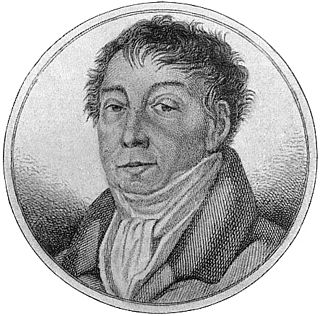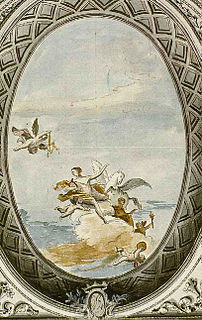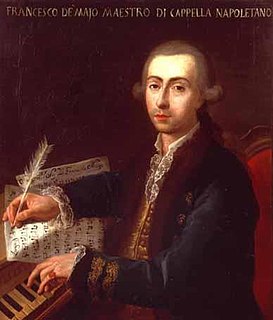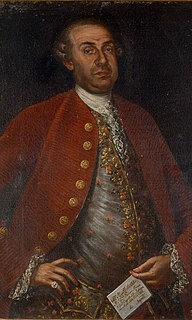
Niccolò Jommelli was an Italian composer of the Neapolitan School. Along with other composers mainly in the Holy Roman Empire and France, he was responsible for certain operatic reforms including reducing ornateness of style and the primacy of star singers somewhat.

Opera seria is an Italian musical term which refers to the noble and "serious" style of Italian opera that predominated in Europe from the 1710s to about 1770. The term itself was rarely used at the time and only attained common usage once opera seria was becoming unfashionable and beginning to be viewed as something of a historical genre. The popular rival to opera seria was opera buffa, the 'comic' opera that took its cue from the improvisatory commedia dell'arte.

Luigi Marchesi was an Italian castrato singer, one of the most prominent and charismatic to appear in Europe during the second half of the eighteenth century.

L'Olimpiade is an opera libretto in three acts by Metastasio originally written for an operatic setting by Antonio Caldara of 1733. Metastasio’s plot vaguely draws upon the narrative of "The Trial of the Suitors" provided from Book 6 of The Histories of Herodotus, which had previously been the base for Apostolo Zeno's libretto Gli inganni felici (1695). The story, set in Ancient Greece at the time of the Olympic Games, is about amorous rivalry and characters' taking places to gain the loved one. The story ends with the announcement of two marriages.

Lucrezia Aguiari was an Italian coloratura soprano. She possessed an unusually agile voice with a large vocal range that spanned slightly more than three and a half octaves; faculties that enabled her to perform the most difficult passage work. In a letter dated 24 March 1770 Leopold Mozart wrote of hearing her perform a C an octave above high C at the Ducal opera of Parma, "I could not believe that she was able to reach C soprano acuto, but my ears convinced me." Aldous Huxley also mentioned this event in his novel, Brave New World,.
Demofonte is an opera seria libretto by Metastasio. The libretto was first set by Antonio Caldara in 1733, but remained popular throughout the eighteenth century and was set over seventy times.

Didone abbandonata is an opera libretto in three acts by Pietro Metastasio. It was his first original work and was set to music by Domenico Sarro in 1724. The opera was accompanied by the intermezzo L'impresario delle Isole Canarie, also by Metastasio.
Giovanni Bertati was an Italian librettist.

Joseph Schuster was a German composer.

The Teatro San Moisè was a theatre and opera house in Venice, active from 1620 to 1818. It was in a prominent location near the Palazzo Giustinian and the church of San Moisè at the entrance to the Grand Canal.

Caterina Gabrielli, born Caterina Fatta, was an Italian coloratura singer. She was the most important soprano of her age. A woman of great personal charm and dynamism, Charles Burney referred to her as "the most intelligent and best-bred virtuosa" that he had ever encountered. The excellence of her vocal artistry is reflected in the fact that she was able to secure long-term engagements in three of the most prestigious operatic centers in her day outside of Italy.
Gennaro Astarita was an Italian composer, mainly of operas. The place of his birth is unknown, although he was active in Naples for many years. He began his operatic career in 1765, collaborating with Niccolò Piccinni in the writing of the opera L'orfana insidiata. He became the maestro di cappella in Naples in 1770.
Gregorio Babbi was an Italian operatic tenor. He performed in the premieres of numerous operas, including works by Girolamo Abos, Pietro Auletta, Andrea Bernasconi, Giuseppe de Majo, Giuseppe Ferdinando Brivio, Pasquale Cafaro, Gioacchino Cocchi, Nicola Conforto, Pasquale Errichelli, Baldassarre Galuppi, Giuseppe Gazzaniga, Geminiano Giacomelli, Giovanni Antonio Giay, Johann Adolph Hasse, Niccolò Jommelli, Gaetano Latilla, Leonardo Leo, Gennaro Manna, Antonio Maria Mazzoni, Davide Perez, Niccolò Piccinni, Nicola Sabatino, Giuseppe Scarlatti, Tommaso Traetta and Antonio Vivaldi among others.

Gian Francesco de Majo was an Italian composer. He is best known for his more than 20 operas. He also composed a considerable amount of sacred works, including oratorios, cantatas, and masses.

Gennaro Manna was an Italian composer based in Naples. He was a member of the Neapolitan School. His compositional output includes 13 operas and more than 150 sacred works, including several oratorios.
Antonio Palomba (20 December 1705 - 1769) was an Italian opera librettist, poet, harpsichordist, and music educator. He also worked as a notary. Born in Naples, he became a teacher of the harpsichord at the Teatro della Pace in 1749. Most of his more than 50 opera libretti were comedic works written for composers of the Neapolitan school. He also wrote some works for performance in Florence, Bologna and abroad. He died in Naples in 1769; one of the victims of a fever epidemic in the city. Many of his libretti were set more than once to music, and composers continued to use his libretti up into the 1830s.

In music history, the Neapolitan School is a group, associated with opera, of 17th and 18th-century composers who studied or worked in Naples, Italy, the best known of whom is Alessandro Scarlatti, with whom "modern opera begins". Francesco Provenzale is generally considered the school's founder.
It is with the Neapolitan school...that the History of Modern Music commences—insofar as that music speaks the language of the feelings, emotions, and passions.
Giovanni Ansani was an Italian tenor and composer.
Antonio Boroni was an Italian composer.
Ipermestra is an opera libretto by Pietro Metastasio first set by Johann Adolph Hasse 8 January 1744, and in the November of the same year by Christoff Willibald Gluck.












